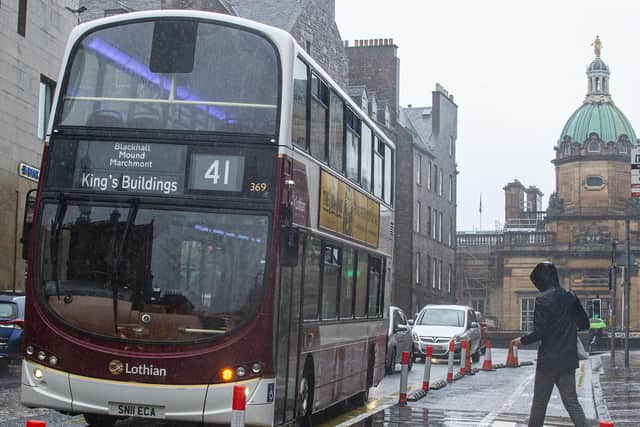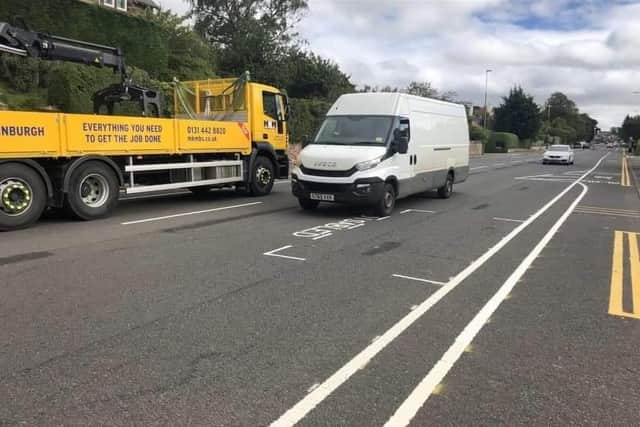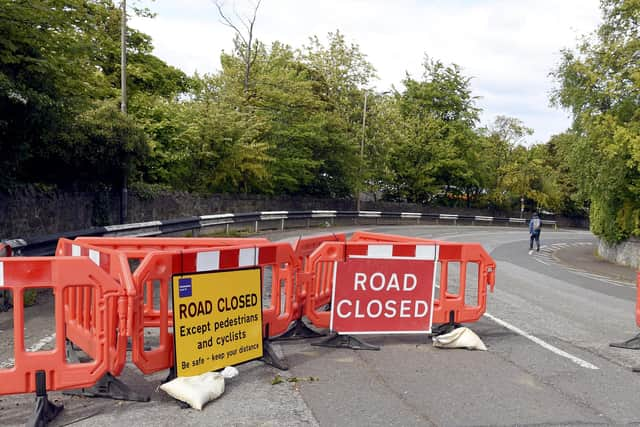How Edinburgh's Spaces for People scheme sparked controversy after controversy
and live on Freeview channel 276
Let us know what you think and join the conversation at the bottom of this article
And often the lack of consultation with local communities and those affected has been cited as the biggest concern.
Transport Secretary Michael Matheson announced in April the Scottish Government would provide full funding for councils to introduce schemes involving "pop-up" cycle lanes and wider pavements.


Advertisement
Hide AdAdvertisement
Hide AdHe noted a 35 per cent increase in cycling, more people walking and a 90-95 per cent fall in public transport use and called for "bold and ambitious" plans which could be implemented in "a couple of weeks".
Edinburgh was awarded £5m and temporary cycleways on Old Dalkeith Road to the Royal Infirmary and Crewe Road South to the Western General Hospital were among the early initiatives.
In the city centre, Waverley Bridge was closed and Cockburn Street and Victoria Street shut to traffic except for limited delivery times.
Altogether the scheme in the Capital has seen 29 road closures and 39km of segregated cycle lanes.


Advertisement
Hide AdAdvertisement
Hide AdA "floating" bus stop on George IV Bridge, positioned between the main carriageway and a cycle lane, was criticised by sight-loss charity RNIB for creating "an unacceptable level of risk" for passengers getting on and off buses straight into the path of cyclists. It went ahead despite the protest, but plans for similar ones as part of the Lanark Road Spaces for People scheme were later dropped.
In local town centres like Stockbridge, Morningside, Bruntsfield and Tollcross, pavements were widened to make it easier for shoppers to keep two metres apart, but it meant a reduction in parking spaces and that sparked protests from traders.
They argued elderly people often needed dropped off by car to get their messages or go to the hairdresser and warned a parking ban would "kill off" the high street.
A disabled parking bay painted in the middle of the road on Pentland Terrace in Comiston, part of the busy A702, was labelled "crazy" and an accident waiting to happen.


Advertisement
Hide AdAdvertisement
Hide AdThe bay, several feet from the pavement with a cycle lane in between, meant anyone getting out of the car would either be stepping into a busy arterial road or risking collision with a bike.
The council insisted it complied with design guidance but later removed it after the couple who requested it said they would not be able to use it in such a position.
The closure of Braid Road in Morningside was one of the most controversial moves under Spaces for People, with claims it led to increased congestion on the Comiston Road and led to standing traffic pumping out toxic emissions next to South Morningside Primary School playground.
But one Braid Road resident wrote to the Evening News describing the lack of speeding vehicles, vans, large lorries and tour buses as "blissful".
Advertisement
Hide AdAdvertisement
Hide AdLocals were left scratching their heads when double yellow lines were painted on the traffic-free road. And during the cold weather last December a woman suffered a suspected broken wrist after falling on ice on Braid Road amid claims it had not been gritted despite being closed to make it "safe" for pedestrians and cyclists.
There was also controversy over the measures for Lanark Road, including segregated cycle lanes, narrower carriageways and reduced parking provision. Concerns were raised about increased congestion, access to driveways and the effect on local businesses from loss of parking, as well as claims that the steepness of the road in places made it an unlikely cycle route for many when alternatives were available.
Council officials were accused of "anti-democratic spin" when they claimed over 300 emails had been received from the public "both in favour and against" the scheme, only for it to emerge that 300 were against, 19 in support and 10 neutral.
Residents in East Craigs and Craigmount fought a determined campaign against plans for a series of road closures, junction changes and cycle lanes to create a "low traffic neigbourhood". Transport convener Lesley Macinnes was given a hostile reception when she attended an open-air public meeting of up to 1000 people in Gyle Park and after threats of legal action and further consultation the plans were put on hold.
Advertisement
Hide AdAdvertisement
Hide AdAnd in spring this year there was new controversy when planters appeared at junctions leading to school entrances. One Baberton resident was “flabbergasted” to be confronted by one of the wooden boxes filled with soil, plonked in the middle of the road with no warning. The planters are to allow access for pedestrians and cyclists only, creating a safer route for children, families and carers travelling to school.
The council has argued the beauty of Spaces for People is the ability to devise and revise, putting schemes into effect and then amending them in response to feedback.
And it has insisted it has no intention of using the scheme to push through longer-term changes.
The Temporary Traffic Regulation Order did not require the normal full public consultation, but the council did involve "key stakeholders" including councillors, community councils and business representatives, who were given five days to review the plans and submit feedback prior to their confirmation.
Advertisement
Hide AdAdvertisement
Hide AdEarlier this year the council launched a consultation on making some of the initiatives permanent and in June councillors agreed to keep some of the measures for a further 18 months, meaning certain "temporary" traffic schemes will have been in place for three years before either being made permanent or scrapped entirely.
A message from the Editor:
Thank you for reading this article. We're more reliant on your support than ever as the shift in consumer habits brought about by coronavirus impacts our advertisers.
If you haven't already, please consider supporting our trusted, fact-checked journalism by taking out a digital subscription.
Comment Guidelines
National World encourages reader discussion on our stories. User feedback, insights and back-and-forth exchanges add a rich layer of context to reporting. Please review our Community Guidelines before commenting.
